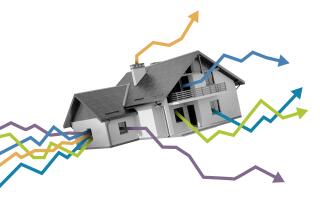Housing Starts Decline Throughout the Nation : Economy: Slipping demand for new homes mirrors yearlong increase in mortgage rates.
- Share via
WASHINGTON — Construction of new homes slumped in every region of the country in October, the Commerce Department said Thursday, as sharply rising mortgage rates put the brakes on building activity.
The report shows that before the Federal Reserve Board’s decision Tuesday to boost short-term interest rates for a sixth time this year, building activity was already losing steam, prompting charges that the Fed overreacted.
The Commerce Department said the annual rate of starts on new homes dropped 5.2% to a seasonally adjusted annual rate of 1.42 million units--the first decline in four months--after a revised rise of 2.3% in September.
The decrease in home building was entirely for single-family homes, which plunged 7.4% to a rate of 1.14 million--the lowest since February--as the impact of stiffer monthly mortgage payments on consumers’ budgets came into play.
By contrast, construction starts on new multiple-unit apartment buildings increased 4.8% in October to a rate of 282,000 a year.
Mortgage interest rates have risen about three percentage points since hitting bottom in October, 1993, enough to add about $300 a month to the payment on a typical $100,000 mortgage.
According to the Federal Home Loan Mortgage Corp., the rate for a 30-year mortgage rose this week to 9.12%. That compares to 6.74% in October, 1993.
Those rates are headed still higher after the Fed’s move this week to boost short-term interest rates by three-quarters of a percentage point--raising the cost of money to banks and prompting them to swiftly push up their business lending rates.
Building was weaker last month in every region.
Housing starts fell 6.3% in the West to an annual rate of 356,000. They were off 6.1% in the Northeast at 123,000 and dropped 9.6% in the Midwest to 300,000. In the South, they fell 2.1% to a rate of 640,000.
Permits to build new homes, often a barometer of future activity, also fell in October, by 1.7% to a rate of 1.4 million a year after rising 5.2% in September.
There were signs Thursday that other economic sectors remained robust despite earlier rate increases:
* The Federal Reserve Bank of Philadelphia said its index of regional business activity fell to 30.5 from 33.2 in November. But the survey indicates increases in employment and the average workweek, and most indications of future economic activity rose.
* The Labor Department said new applications for unemployment benefits fell 5,000 last week from a week earlier to 327,000, but the closely watched four-week average crept up to a two-month high. California, however, reported the largest increase, with 13,571 new jobless claims.
* The National Assn. of Realtors said a strong economy helped boost prices of existing homes 2.7% to $111,000 in the third quarter, with the largest gains in the West.
In California, however, prices declined from the same period in 1993. San Francisco again had the most expensive market for existing homes in California, averaging $250,200, down 1.5%. In Los Angeles, the average price was $189,000, down 2.9%, and Anaheim had an average price of $217,000, a drop of 0.8%. San Diego’s average price fell 0.6% to $175,400 and Riverside fell 4.9% to $175,400.
Housing Starts
Seasonally adjusted annual rate, in millions of units:
October 1994: 1.42
Source: Commerce Department
More to Read
Inside the business of entertainment
The Wide Shot brings you news, analysis and insights on everything from streaming wars to production — and what it all means for the future.
You may occasionally receive promotional content from the Los Angeles Times.









